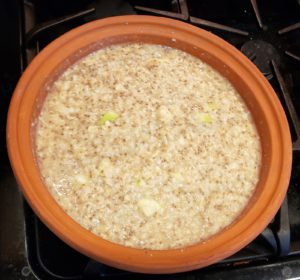Best Cookware for Cooking & Eating Healthy Foods
So, after some time spent researching this topic, we had an idea to write an article for all our readers out there to quickly go over all the best cookwares for cooking and eating healthy foods. After all, you have made the decision to eat healthy foods and what good is there to lose the nutrients you are trying to get from those healthy foods through using the wrong cookware?
So, Just What are the Options of Healthy Cookware?
If you are remotely health conscious, then you know just how important highly nutritious foods are to maintaining good health.
This brings us to our first pick when it comes to healthy cookware – earthen pots. These pots are most commonly known as clay pots or clay cookware. They are an olden way of cooking, but a goodie. And if it works why change it?
Disclaimer:
Healthylivingfromheadtotoe.com is a participant of Amazon Services LLC Associates Program, which is an affiliate advertising program. It is a way for sites like ours to have the opportunity to earn advertising fees through advertising and linking to Amazon.com.

However, over the course of time, we have seen an upsurge in a variety of cookware from nonstick to a myriad of metal based cooking pots and pans. Some are natural metals, like cast iron and copper. And others are man-made blends that come in coated and non-coated varieties – think teflon coated aluminum pots and pans, carbon steel, stainless steel, and other metal cookware and bakeware. All of which are readily available to the masses.
Most of these metal based cookware provide the convenience of faster cooking, perfect searing, and great versatility which includes the ability to fry and deep fry foods, but at the cost of nutrients.
Earthenware Pots
Earthen pots allow foods to be cooked with the optimum amount of nutrients/ micronutrients locked in, providing a more nutritious meal.
The benefits of cooking with clay are great and far outweigh the cons. One such con being that cooking time is a bit longer, but often times improves over the course of time. Another con is most clay cookware need to be cured before use.
One more con when it comes to clay pot is actually dependent on whether you are familiar with cooking with clay. And if you aren’t, you might find yourself faced with quite a bit of a learning curve. But, it is very easy to overcome and you can become quite the expert when it comes to cooking with clay. So much so, that you will find out that it is certainly worth it to have at least one or two of these pots in your kitchen.
One of the major benefits of using clay cookware is that your food is that much healthier, in the sense that you are able to eliminate some of the toxins in the foods. This really comes into play if you are unable to purchase organic foods and grass fed meats on a regular basis.
The porous nature of clay pots and their negative charge or alkaline nature, enable them to pull toxic substances that may bre present in certain foods. This can be visible in thre form of brownish or blackish sticky bubbling out of these impurities. This allows for more bioavailability of the nutritional elements in your food without the extra gunk.
According to a lab test done in India, food cooked in clay pots retain a higher percentage of micronutrients compared to foods cooked in cookware made from other materials. So, that alone should give you reason to at least give this type of cookware a try.
What Features to Look for when Shopping for Your Earthenware Clay Pot
You may be wondering, what features to look for when shopping for your earthenware or earthen pot; so here are some things to keep in mind.
When looking at earthenware pots or clay vessels, unglazed is best. This not only reduces the likelihood of exposing your food to lead, since it can leach into your food while cooking (the glaze process often times includes the use of lead), but provides you with the benefits of nutrient retention and evenly cooked food. Not to mention the foods cooked in earthen pots are often times more flavorful and taste absolutely delicious. Plus your food stays warm longer (four to five hours later you will be able to have warm, not hot, but warm food).

If you haven’t done so, try cooking beans in your earthen pots, the taste is absolutely fantastic! Even rice tastes more delicious when cooked in clay.
Stoneware Pots
Much like Earthenware Pots, this cookware is also made of clay and heats evenly. The main difference; however, is that this clay cookware is fired in the kiln at a much higher temperature than regular clay or earthen pots. This results in a less porous cookware and a slight difference in the level of flavor acquired during the cooking process.
Soapstone or Steatite Cookware
When it comes to Steatite Cookware, better known as soapstone, this cookware, much like earthen or clay cookware gives not only even heating, but retains the nutritional benefits when used to cook your food. Also, it doesn’t react or leach into foods and is a great way to prepare healthy foods and will last for a lifetime when used properly.
Although naturally a softer stone, once cured, cookware made from this stone is highly durable and can provide you with peace of mind when cooking your healthy meals.
Just be sure that the stone used for your cookware is not sourced from California as it tends to contain some strands of asbestos engrained in the rock. Which might pose a health hazard when there is damage to the pot or if it breaks and particles become airborne.
You can always take the added step of checking with the pot manufacturer (or even the retailer) to determine where the rock is sourced and whether there are tests done to ensure there are no asbestos strands occurring within the rock.
Cast Iron Cookware
When seasoned well these can bring added depth of flavor to meats and veggies. For the perfect seared steak, cast iron is certainly the way to and is one of two metal cookware we are willing to recommend.

Unlike clay cookware, this cookware can react with certain foods, especially acidic foods like tomato sauce or paste when not well seasoned.
As far as leaching is concerned, the amount of iron transferred to your food is minimal and is thought to be not so readily available or lacking bioavailability. I however, believe it can be useful to the body.
The only ways you will encounter a large amount of leaching is if you are cooking on bare, unseasoned cast iron; cooking very acidic foods; or letting your food sit in iron vessels for a long time – neither of which we would recommend.
Copper Cookware
If you love making jams and would like to avoid using pectin, copper is the way to go. It reacts with fruits to naturally thicken jams and jellies for wonderful homemade treats.

Now, there is debate as to the safety of copper pots and the potential of leaching into foods; however, copper is a metal that is useful in the body, and the body doesn’t make it own, so an external source is needed….
Conclusion
So, whatever cookware you choose from the aforementioned list is truly up to you, but we highly recommend one of each or at least the following: a clay soup pot, a cast iron skillet, a cast iron Dutch oven, and a copper pan. These pots and pans should get you well on your way to cooking any meal you so desire with little to no health concerns.
If you enjoyed this and any of our other articles, do feel free to share, like, and also subscribe for more articles.
Thanks for reading!
#targetstores


